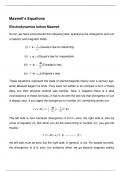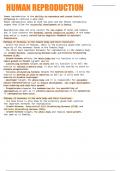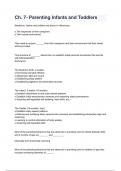Section A: Introduction
Chapter 1: A framework understanding Inclusion
1.1 Introduction
o Inclusion is :
complex,
multidimensional
controversial concept.
1.2 What is inclusion?
o Inclusion has become a buzzword,
o Can be seen in policy documents, media statements and newspapers.
o The broad principles common between definitions of inclusion are:
Dedication to building a more democratic society
More equitable & quality orientated educational system
Belief that extends the responsibility of regular schools to accommodate the
diverse learning needs of all learners
o The wider sense:
About developing inclusive community & education systems
Based on a value system that invites and celebrates difference & diversity
diversity = gender, nationality, race, language, socio-economic background,
cultural origin, level of educational achievement & disability
o Inclusion about ensuring the access, active participation, success of everyone
o regardless of difference
o Inclusion - expression of individual human rights & social justice
o Worldwide movement with a global agenda
o International & RSA definitions of inclusion is important to understand different
interpretations and histories
,1.3 Inclusion in an international context
1.3.1 Changing paradigms
o Schools = affected by developments & changes in society
o Society grows → schools become outdated
o response to rapidly evolving social, political & economic contexts is to create schools that
are grounded in democratic principles and constructs of social justice
o Changes in learning grows parallel to changes in thinking
o New perspectives/paradigms
o Skrtic a paradigm/worldview is:
“a shared pattern of basic beliefs and assumptions about the nature of the world and
how it works. These assumptions tell us what is real and what is not; they shape our
cultural identity and guide and justify our institutional practices”.
o Paradigms = enabling, can be restrictive towards growth
1.3.2 The medical deficit model
o 1970’s rapid paradigm shift from a medical deficit model (within-child model) to a social
systems change approach
o Model used to direct beliefs & ideas which they demonstrated in their methods, they used
the models as an explanatory framework too
o Inclusion= prominent in educational systems now, however with an explanatory framework
the medical model is predominant
o Model explained by diagnosing (ADHD/behavioural problems) & fixing (remedial
education/special class)
o useful in the medical field
o social sciences the problem is possible not only in the child but also in the community the
child functions in
o When applied there is a search for the problem within the child & then singled out (disabled)
o Process:
assess the child’s strengths & weaknesses,
find diagnosis
categorize / label the child
,o Children who fell outside the norm → sent to special schools/classes to fix & alleviate their
differences
o Special staff/ curriculum aimed at fixing child
o Reasoning for using model: to benefit the problem child & normal majority
o Medical model based on positivist philosophy:
scientific knowledge objective,
empirical,
observable only source of correct knowledge about reality
o A person’s disability is determined by a dynamic interaction between biological, individual
and social perspectives (Bronfenbrenner’s model)
1.3.3 The social ecological model
o The paradigm shift became when normalisation was introduced in Western society in
1960’s
o Normalisations = that all people who are disabled should enjoy patterns & conditions of
everyday living which are as close as possible to the mainstream society
o Normalisation in direct conflict with medical model
o Mainstream:
Mainstreaming is mostly used in the US,
Integration is used more in European countries
Mainstreaming is the educational equivalent of normalisation principle
it suggests that people with disabilities have a right to life experiences that are the
same /similar to those of anyone else in society
Goal: to return learners with disabilities to mainstream of education as much as
possible, alongside normal peers
When implemented (US) children were allowed to visit general education classes for
short periods of time, mostly in non-academic classes – it applied to learners with
mild disabilities mostly
Supporters believed learners must earn opportunity to be mainstreamed & work
harder to keep up with the work assigned to all the normal learners in the class
If special education was necessary it was provided in special environments such as
a resource room
, Mainstreaming- school & class remained the same, setting never changed to accept
the child
Criticised: because it doesn’t provide learners with sufficient support to benefit from
regular education
o Integration:
Humanitarian & civil rights issues drove policies leading to integration
Examples: No child left behind act 2001 US
goal: ensure that learners with disabilities are assigned equal membership in the
community
aims: to max the social interactions between disabled & non-disabled learners
different interpretations of integration
involved more extensive & holistic participation for learners with disabilities in relation
to mainstreaming (only visiting some classes, mostly non-academic), while more time
were still spent on special needs in separate settings
Special services followed the learner to the regular school, mainstreaming the
learner was still in a special school – only visiting mainstream school classes
o Inclusion can be described as a reconceptualization of values &beliefs that welcomes &
celebrates diversity and not only a set of practices
o UNESCO (accommodate all children regardless of their disabilities): these inclusive
education systems must recognise & respond to:
diverse needs of their students,
accommodating different styles & rates of learning,
ensuring quality education to all through appropriate curricula,
organisational arrangements,
teaching strategies,
resource use
partnerships with their communities
o This statement by UNESCO was based on the grounds of the following:
The education of all learners together needs development in teaching practices that
can accommodate individual differences & benefit all learners
Inclusive schools are non-judgemental & embrace differences which creates a non-
discriminatory society
Educating all learners together is more cost-effective
Chapter 1: A framework understanding Inclusion
1.1 Introduction
o Inclusion is :
complex,
multidimensional
controversial concept.
1.2 What is inclusion?
o Inclusion has become a buzzword,
o Can be seen in policy documents, media statements and newspapers.
o The broad principles common between definitions of inclusion are:
Dedication to building a more democratic society
More equitable & quality orientated educational system
Belief that extends the responsibility of regular schools to accommodate the
diverse learning needs of all learners
o The wider sense:
About developing inclusive community & education systems
Based on a value system that invites and celebrates difference & diversity
diversity = gender, nationality, race, language, socio-economic background,
cultural origin, level of educational achievement & disability
o Inclusion about ensuring the access, active participation, success of everyone
o regardless of difference
o Inclusion - expression of individual human rights & social justice
o Worldwide movement with a global agenda
o International & RSA definitions of inclusion is important to understand different
interpretations and histories
,1.3 Inclusion in an international context
1.3.1 Changing paradigms
o Schools = affected by developments & changes in society
o Society grows → schools become outdated
o response to rapidly evolving social, political & economic contexts is to create schools that
are grounded in democratic principles and constructs of social justice
o Changes in learning grows parallel to changes in thinking
o New perspectives/paradigms
o Skrtic a paradigm/worldview is:
“a shared pattern of basic beliefs and assumptions about the nature of the world and
how it works. These assumptions tell us what is real and what is not; they shape our
cultural identity and guide and justify our institutional practices”.
o Paradigms = enabling, can be restrictive towards growth
1.3.2 The medical deficit model
o 1970’s rapid paradigm shift from a medical deficit model (within-child model) to a social
systems change approach
o Model used to direct beliefs & ideas which they demonstrated in their methods, they used
the models as an explanatory framework too
o Inclusion= prominent in educational systems now, however with an explanatory framework
the medical model is predominant
o Model explained by diagnosing (ADHD/behavioural problems) & fixing (remedial
education/special class)
o useful in the medical field
o social sciences the problem is possible not only in the child but also in the community the
child functions in
o When applied there is a search for the problem within the child & then singled out (disabled)
o Process:
assess the child’s strengths & weaknesses,
find diagnosis
categorize / label the child
,o Children who fell outside the norm → sent to special schools/classes to fix & alleviate their
differences
o Special staff/ curriculum aimed at fixing child
o Reasoning for using model: to benefit the problem child & normal majority
o Medical model based on positivist philosophy:
scientific knowledge objective,
empirical,
observable only source of correct knowledge about reality
o A person’s disability is determined by a dynamic interaction between biological, individual
and social perspectives (Bronfenbrenner’s model)
1.3.3 The social ecological model
o The paradigm shift became when normalisation was introduced in Western society in
1960’s
o Normalisations = that all people who are disabled should enjoy patterns & conditions of
everyday living which are as close as possible to the mainstream society
o Normalisation in direct conflict with medical model
o Mainstream:
Mainstreaming is mostly used in the US,
Integration is used more in European countries
Mainstreaming is the educational equivalent of normalisation principle
it suggests that people with disabilities have a right to life experiences that are the
same /similar to those of anyone else in society
Goal: to return learners with disabilities to mainstream of education as much as
possible, alongside normal peers
When implemented (US) children were allowed to visit general education classes for
short periods of time, mostly in non-academic classes – it applied to learners with
mild disabilities mostly
Supporters believed learners must earn opportunity to be mainstreamed & work
harder to keep up with the work assigned to all the normal learners in the class
If special education was necessary it was provided in special environments such as
a resource room
, Mainstreaming- school & class remained the same, setting never changed to accept
the child
Criticised: because it doesn’t provide learners with sufficient support to benefit from
regular education
o Integration:
Humanitarian & civil rights issues drove policies leading to integration
Examples: No child left behind act 2001 US
goal: ensure that learners with disabilities are assigned equal membership in the
community
aims: to max the social interactions between disabled & non-disabled learners
different interpretations of integration
involved more extensive & holistic participation for learners with disabilities in relation
to mainstreaming (only visiting some classes, mostly non-academic), while more time
were still spent on special needs in separate settings
Special services followed the learner to the regular school, mainstreaming the
learner was still in a special school – only visiting mainstream school classes
o Inclusion can be described as a reconceptualization of values &beliefs that welcomes &
celebrates diversity and not only a set of practices
o UNESCO (accommodate all children regardless of their disabilities): these inclusive
education systems must recognise & respond to:
diverse needs of their students,
accommodating different styles & rates of learning,
ensuring quality education to all through appropriate curricula,
organisational arrangements,
teaching strategies,
resource use
partnerships with their communities
o This statement by UNESCO was based on the grounds of the following:
The education of all learners together needs development in teaching practices that
can accommodate individual differences & benefit all learners
Inclusive schools are non-judgemental & embrace differences which creates a non-
discriminatory society
Educating all learners together is more cost-effective







